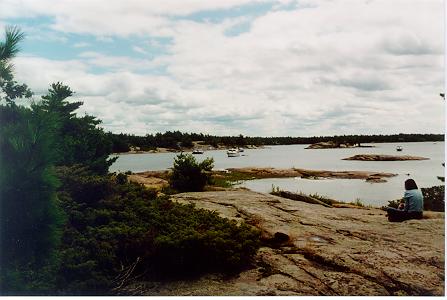|
|
|
|
Georgian Bay Sailing-Camping Day 2 The next morning we woke up to another warm, humid day, and from our weather radio we found that Environment Canada had issued a small craft wind warning with 20-30 km wind forecasted for the Parry Sound area. Georgian Bay was forecasted to have 15-20 knots wind. But at the bay sheltered by the island from the open water and the westerly, wind was light and perfectly sailable. The park has a hiking trail that runs from Cedar Springs in the south to the northern end, about a three-hour walk. But who would want to walk through a mosquito-infested trail when one can sail! We took the boat instead, and sailed on a run in a pleasant 5-knot wind. |
|

|
Beausoleil Bay at the northern end of the island is a nice, sheltered bay perfect for swimming, fishing and light sailing. There is also a dock and a large number of first-come, first-campsites. This is a favorite anchorage area for powerboats and sailboats. |
|
These are five-star campsites, spacious, all bordering water, and are well maintained by the Park. Some sites even have rustic air-tight iron wood-burning stoves, for those who want to keep warm efficiently during cold days! Here is one such sites: |

|
|
By late afternoon the sky was turning dark and the wind picked up. We headed back to the main campground on an exciting reach with shifting winds from the west and south-west. As we left Beausoleil Bay and approached the relatively open water between Roberts Island and Cedar Springs, wind strengthened to around 15 knots with over 20 knots gusts, and white caps were quickly beginning to form. The Hen can safely sail in these conditions, but we figured we had several tacks to make our way up the strong headwind, and prudence calls for reefing down the main sail. As we hove-to and worked to tie down the reefs, another gust hit us, and the force exerted on the jib pried open the jib clew shackle. The jib proceeded to flutter wildly in the wind and an old, six-inch long rip (obviously inadequately repaired) was torn open. This was beginning to get worrying, so we decided to save the battle for another day and hauled down the sails. Itís one of those times that I am thankful that I have a roller furling, as the simultaneous tasks of letting down the two sails, staying balanced, avoiding the ugly shoals, while starting the motor, would have been quite a handful for me and my daughter!
We safely returned to the beach, anchored down and rewarded ourselves with a big warm supper. We found that Environment Canada had issued a full gale warning and thunderstorm advisory for Georgian Bay. The campground is located in an old-growth forest and is well protected the wind, but I watched the tops of 50-feet pine trees around us bent into submission by the strong wind, and wondered what would such forces do to unwitting sailboats caught in open waters. Rain began to fall intermittently, followed by one of the longest electric storms Iíve seen. We stood on the beach and watched the thunder-clouds moving in from the west and heading over land, with non-stop lightning flashes lasting over 20 minutes. Thunder-caps became a long, continuous roar before it faded into the distance. The warm humid air was gone and temperature dropped like a rock, to 7 degree by midnight. Fortunately we had our Ė5 degree sleeping bags (at least thatís what the label says), and the cool night made for comfortable sleeping. Wind howled all night, and small broken branches were falling all around us. The large tarp that I tied over the picnic table was flapping up and down and making the same noise as a loose jib. Finally at 3:00AM the tarp suffered the same fate as the jib Ė one corner was torn off from the rope tying it to a tree, and the flapping tarp made the kind of noise that makes any sailor dread. Reluctantly I rushed out of the warmth of the tent and secured the whole setup. Unable to go back to sleep, I walked out to the beach, worrying whether the anchors would hold. Indeed the anchors (er, rock) had dragged at least 10 feet, judging from the relative position of the Hen and neighboring boats. I decided that I would take the risk of causing some stress to my rudder rather than losing my boat altogether, and hauled the boat onshore until it was close enough that I could tie the anchor line to a tree. |
|
|
|
|